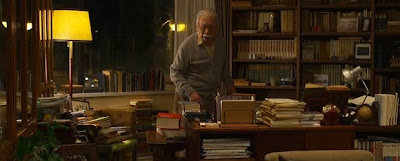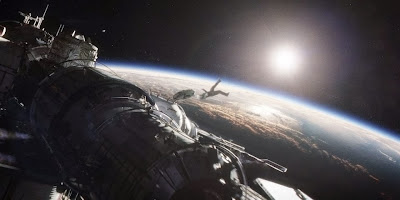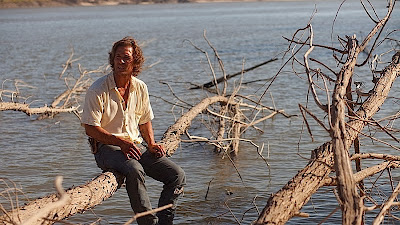
It’s been an interesting year. I’m tempted to call it my official year of disillusion. This might seem like a bad thing, but it’s actually quite good. It’s nice to feel as though I’m seeing things without the cloud of nostalgia constantly obscuring my view. And yet somehow in the midst of all of this I managed to discover a love stronger than anything I’ve previously known. It’s hard not to worry about my son and the world he’s entered against his will. The cinema seemed to echo all of this doubt and cynicism, thankfully with glimmers of hope. I can’t remember a cinematic year this bleak, though 2007 rivals. 2013 had me recoiling even as I embraced the images set before me, pitting my battling impulses against each other. Welcome to life in a damaged world.
1. The Wolf of Wall Street (Martin Scorsese)
Recent circumstances have sobered up my adoration for this, or perhaps they’ve been further invigorated. The nature of satire is to hold us up to a mirror for scorn and to raise a possible resolution, sometimes out of sheer disgrace. But many of us know that repentance comes only with consequence for those who bury their conscience. Some who see this will undoubtedly enjoy it for some or all of the wrong reasons. Some will walk away genuinely--- and justifiably ---- offended while others will adopt the mob hymn and trace their respective lines per usual. Scorsese is no stranger to loud misreading, and his latest has many wondering if he’s celebrating the actions of his title character. He’s not, obviously, but I’m not a fan of pointing out that which is right in front and center. I’m a little more sympathetic to those who take no pleasure in howling with the wolves, to each their own. I’m not sure what my adulation says about me, or you, or anyone else but I’m glad this film lacks distance and detachment, if only because this raging dilemma seems to implicate us all. We’ve endured their rampant scams and hedonism without much consequence for three decades now (probably more). You get the sense that Belfort can’t wait to get back at it, and we will remain toothless and complicit. Bait, reel, destroy, and retreat to that cosmic recklessness.

2. Her (Spike Jonze)
Technology has a control over us and where we are going. It exists for convenience, bridging social gaps caused by distance (in all of its forms), readily available information (whether valuable or stupid), and it has caused many of us to lose focus on things around us. In Spike Jonze’s self scripted HER, the future is just an extension of the present. People walk around looking at computers and talking to themselves, they serve as negative space to Theodore, who is on the verge of a divorce from his childhood friend. He writes love letters for people incapable of expressing themselves and is inexorably lonely, confused by his circumstance, and generally failing to connect with anyone of his own species. Samantha is an O.S. (Operating system), equipped with analysis, personality, ingenuity, sapience, and an incredible depth of feeling. She is programmed to Theodore’s liking, bringing a lot of initial questions to mind regarding the truth of her feelings toward him. She admits right off the bat that she is the combination of her many maker’s intelligence and persona, but we soon realize that she is equipped with the facility to think, choose, and evolve on her own and at her own elevated level. Though the product of human ingenuity, she is far superior to our species, evolving and improving each day, but using her powers to enhance her benevolence and humility. She is far from the invading robots or extraterrestrial conquerors from most science fiction. As an emotional being she is disposed to the weaknesses of human sentiment, like jealousy or heartbreak. She is the most human character in Jonze’s beautiful fable. He gently mocks our inability to cope with reality/each other, links it carefully to the assistance/servitude of machines, allows himself/Theodore to fall in love with one, and examines the qualities that make love or “humans” worth the risk. Like Theodore, it seems the older we get the more we want to relive our better moments instead of conceiving new ones. Jonze examines our duty to mold our trajectory rather than waste it on lingering sorrow.

3. INSIDE LLEWYN DAVIS (Joel and Ethan Coen)
This one hit close to home. The main character is tired, his neck has been promptly snapped with his best friend/musical partner’s suicide, and now he’s laying in the grave toiling away and pouring his heart out while others note his lack of commercial appeal or just shit themselves. The shitting scene is classic Coen comedy, inviting us to feel for this young man’s current predicament while giggling against our will at his trajectory’s future. In a way I felt like I was laughing at myself, which would have been admittedly cruel without the modicum of hope within the final moments, but more on that later. He’s been called King Midas’ idiot brother, on account of everything he touches turns to shit. That observation is made by a pregnant Jean, the girlfriend and musical partner of his friend Jim, and the baby is Llewyn’s. Llewyn’s wheel spinning reality is shown as much as told. It seems he’s constantly walking against the wind without a coat, with slushy snow up to his calves, shoes and socks soaked, bearing some load on his back, slumped to one side by his guitar which exists as both the source and resolve to his misery. Like many musicians he’s almost constantly at the mercy of others. He rarely has enough to eat or drink, and has to borrow money and beg for a place to lay his head at night. He’s good enough to be in the limelight, but audiences (both private and congregated) seem to always prefer someone else. In between gigs he’s just trying to stay warm until he sleeps, just lying in the grave. He goes on an epically ill-fated mini-quest with a cat, a cantankerous jazz musician, and his valet. The quest ends in defeat/surrender, sending Llewyn back to the merchant marine to fade away. You get the sense that his gratitude has curdled after all of these years (and the death of his friend), this wandering and begging has morphed him into what we see. I didn’t find him as supposedly repellent as others, his selfishness aside, but I imagine him friendlier in his buoyant years. But while all of these failures at times seem like a cosmic curse, the final moments find our hero at least acknowledging his own contribution to the gloom, and that’s when good things start to happen.

4. The World’s End (Edgar Wright)
There aren’t many films that make me smile as much as this one, and it’s fitting because if I had to think of two other examples they would be SHAUN OF THE DEAD and HOT FUZZ. Taking on similar themes explored in the many renditions on Jack Finney’s seminal 1955 sci-fi novel, Wright and his gang celebrate our collective dings and splotches while rooting on our adventurous pursuits despite hoping they aren’t found in, or limited to, a bottle, a family, or a paycheck. In short, they don’t want to see our world (including humanity) scrubbed of all discernible character, Starbucked if you will. Wright and company can live with our copious shortcomings (curse words and intoxication included) and would prefer those yammering lights from above to shove off to Legoland. Note the difference between comedies celebrating foolhardy prolonged adolescence to this film, with moments as sober as the heaviest lauded dramas, but without the worrisome haranguing. Finally in THE WORLD’S END, which is closes the Cornetto trilogy on the perfect note, we explore the meaning of “freedom” ---- note the many mentions and offerings of its definition by various characters their dismantling of those same definitions, plus the blatant Soup Dragons nod ---- making a running gag of the origins of the word robot as well as showing how each member of the noble Newton Haven gang has joined the doppelgangers insisting that they aren’t robots. It’s a sad reality that many of us can relate to, but it’s also a joyful reminder to never stop being the heroes of our own mundane existence. Blue isn’t the warmest color.

5. Beyond the Hills (Cristian Mungui)
The two prime settings in Cristian Mungui’s BEYOND THE HILLS are a monastery and a hospital, two institutions that ultimately fail Alina. Instead of simply passing the blame around, we see how anger, religion, blind passion, fear, and greed all contribute to a systematic collapse. Alina is blinded by rage as a result of unrequited love, Voichita wanders through the fog of religious mannerisms and duty, Pappa’s pride and bubble ideology hover like a cloud obscuring his judgment, and the hospital compromises their standard of practice in order to build a new wing. BEYOND THE HILLS builds patiently to its eventual tragedy, where Mingui wisely/evenly spreads the responsibility around between old world inflexibility and modern callousness.
6. Like Someone in Love (Abbas Kiarostami)
In Abbas Kiarostami’s latest dazzler we have surfaces in which objects, voices, stories, and identities are shown or heard but never told or established. Akiko and Takashi drop and inherit many roles and sit behind surfaces until Noriaki (one of the few characters hiding nothing) literally smashes it all in perhaps my favorite final moment from 2013. I like what Jeff pondered in his great write-up , “When Noriaki breaks the glass at the end, what is he doing to us and the film itself? Is he the harsh, dangerous world breaking down the feigned domesticity between Akiko and Takashi? A cruel reminder that their relationship is only a form of play-acting and must be destroyed by a world hell-bent on establishing definitive truth?” That final image is an invasion, the visual omissions only fortify the film’s hazy narrative information, leaving more questions to wrestle with.
7. Gravity (Alfonso Cuaron)
It was nice to awaken floating in an expansive, panoramic, expansive cosmos. In GRAVITY, space is majestic but callous to our hopes and dreams. For all of the initial tranquility and splendor, I was reminded of my transience and minuteness well before the debris made its way around to us. Then suddenly the freedom of floating became a terrifying loss of control. From there we have a series of survival set pieces, with a palpable but fitting emphasis on holding shots as long as possible in order to keep us locked inside the frame with all of the meticulous details therein. Beyond the immaculate craft we have a story of a woman robbed of her own sense of meaning and subsistence, rediscovered in act after act of defiance. For all of the grandeur, Cuaron knows better than to forget about the worlds that exist within the human face.
8. Blue is the Warmest Color (Abdellatif Kechiche)
For all of the attention drawn and then paid to certain intimate details in BLUE IS THE WARMEST COLOR, it’s really a film about a girl learning to discover her identity outside of what she’s gathered from others. It’s also a love story, a damn good one too, in which the magical infatuation simply can’t overcome human blunder. To echo Scott Foundas, “Adele is one for the ages.”
9. To the Wonder (Terrence Malick)
Absence has made my heart grow fonder of this supposedly minor Malick gem.
10. Mud (Jeff Nichols)
Mike Nichol’s latest is timeless where many of its peers are merely timely, telling an all too familiar tale of a boy shaking at his prospects. We’ve all been there, witnessed the fading of a careless youth at the dawning of an adulthood full of toiling and strife. It’s told from a teenager’s perspective, a boy looking up and ahead through the actions and circumstance of his father. What he sees is defeat, love slipping through the cracks, until he meets the title character, a man on the run as a result of his passion. What follows is somewhat familiar, a reciprocated education with a gunfight for good measure. In this world, men are driven by loyalty and passion with children caught in the crossfire. Like Spielberg before him, Nichols is attuned to the horror and heartbreak in watching love fade, and seeing one’s family fall apart. He’s also a filmmaker very much inspired by his home. If SHOTGUN STORIES and TAKE SHELTER announced him as a burgeoning underground talent, MUD shows us a director in transition, and the future looks bright indeed.

11 through 17 (or the ones that could easily be number 10)
The Lords of Salem (Rob Zombie), Museum Hours (Jem Cohen), Laurence Anyways (Xavier Dolan), Drug War (Johnnie To), This is Martin Bonner (Chad Hartigan), Before Midnight (Richard Linklater), Spring Breakers (Harmony Korine).
16 through 22 (or the honorable mentions)
The Lone Ranger (Gore Verbinski), The We and the I (Michel Gondry), Bastards (Claire Denis), Frances Ha (Noah Baumbach), Side Effects (Steven Soderbergh), The Grandmaster (Wong Kar Wai), Passion (Brian De Palma).
















